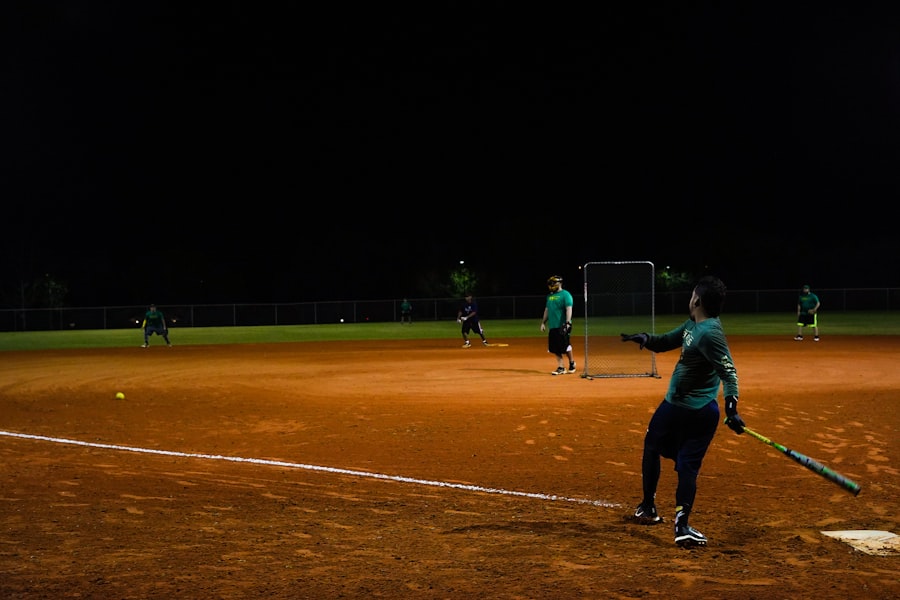Mastering Softball: Tips for Success on the Diamond
Description
Softball is a bat-and-ball sport that shares many similarities with baseball but has its own unique set of rules and gameplay dynamics. Originating in the late 19th century, softball has evolved into a popular sport played at various levels, from recreational leagues to professional competitions. The game is typically played on a diamond-shaped field with four bases, and it can be played in different formats, including fast-pitch and slow-pitch.
The primary objective is to score runs by hitting the ball and successfully reaching home plate after touching each base in order. The fundamental structure of a softball game involves two teams, each consisting of nine to ten players, depending on the format. The game is divided into innings, with each team taking turns to bat and field.
A standard game consists of seven innings, although this can vary in some leagues.
The batter attempts to hit the ball and advance around the bases while the opposing team tries to field the ball and make outs.
Understanding these basic elements is essential for anyone looking to engage with the sport, whether as a player, coach, or fan.
Key Takeaways
- Softball is a team sport similar to baseball, played with a larger ball on a smaller field.
- Fundamental skills in softball include throwing, catching, hitting, and base running.
- Physical conditioning is crucial for softball players to improve strength, speed, and agility.
- Defensive techniques in softball involve positioning, footwork, and communication with teammates.
- Offensive strategies in softball focus on batting techniques, base running, and situational awareness.
Developing Fundamental Skills
Mastering the Art of Hitting
Hitting is one of the most critical skills, requiring a combination of hand-eye coordination, timing, and technique. Players must learn to recognize different pitch types and adjust their swings accordingly. Practicing with a batting tee or participating in live batting practice can help players refine their swing mechanics and improve their ability to make contact with the ball.
Developing Fielding Skills
Fielding is another essential skill that requires agility, quick reflexes, and proper technique. Players must learn how to position themselves effectively to catch ground balls and fly balls while also mastering the art of throwing accurately to their teammates. Drills that focus on footwork, glove positioning, and throwing mechanics can significantly enhance a player’s fielding abilities.
Base Running: A Crucial Aspect of Softball
Additionally, base running is a skill that should not be overlooked; understanding how to read pitches, take leads off bases, and slide safely can make a significant difference in a player’s overall performance.
Improving Physical Conditioning

Physical conditioning is a vital aspect of any athlete’s training regimen, and softball players are no exception. The demands of the game require players to possess strength, speed, agility, and endurance. A well-rounded conditioning program should include cardiovascular exercises to improve stamina, strength training to build muscle power, and flexibility exercises to enhance range of motion. Incorporating activities such as running, cycling, or swimming can help improve cardiovascular fitness, while weightlifting can target specific muscle groups used in throwing and hitting. Agility drills are particularly important for softball players, as they often need to change direction quickly while fielding or running the bases.
Ladder drills, cone drills, and shuttle runs can help improve foot speed and coordination. Additionally, flexibility training through stretching or yoga can prevent injuries and enhance overall athletic performance. By focusing on these aspects of physical conditioning, players can ensure they are physically prepared for the rigors of competition.
Mastering Defensive Techniques
| Defensive Technique | Metrics |
|---|---|
| Blocking | Success rate, number of blocks |
| Tackling | Tackles made, tackle success rate |
| Interceptions | Number of interceptions, interception success rate |
| Positioning | Distance covered, positioning errors |
Defensive play is crucial in softball, as it can often determine the outcome of a game. Mastering defensive techniques involves understanding positioning, communication with teammates, and executing plays effectively. Infielders must learn how to anticipate where the ball will be hit and position themselves accordingly.
This requires not only skill but also an understanding of the opposing team’s tendencies and the pitch being thrown. Outfielders face their own set of challenges, including tracking fly balls and making accurate throws to prevent runners from advancing. Techniques such as the drop step for tracking fly balls or using proper footwork when fielding grounders are essential for success in these positions.
Additionally, defensive communication is vital; players must call for the ball when they are in position to make a play and work together to execute double plays or cut-off plays effectively. By honing these defensive techniques, players can significantly impact their team’s performance on the field.
Enhancing Offensive Strategies
Offensive strategies in softball are multifaceted and require players to think critically about their approach at the plate and on the bases. Batters must develop an understanding of pitch selection and situational hitting. This means recognizing when to swing aggressively for power versus when to focus on making contact to advance runners.
Players should study opposing pitchers’ tendencies and adjust their approach accordingly. Base running is another critical component of offensive strategy. Players must be aware of game situations—such as the number of outs or the score—and make smart decisions about when to take risks on the bases.
Understanding when to steal a base or when to hold up can be the difference between scoring runs or getting thrown out. Coaches often emphasize situational awareness during practice sessions to help players develop their instincts for making quick decisions during games.
Building Mental Toughness

Developing Mental Toughness
Developing mental toughness involves cultivating a positive mindset and employing strategies such as visualization and goal-setting. These strategies can help players overcome obstacles and stay motivated throughout their training and competition seasons.
Visualization Techniques
Visualization techniques can help players mentally prepare for games by imagining themselves successfully executing plays or overcoming challenges. This mental rehearsal can enhance confidence and reduce anxiety before competition.
Goal-Setting for Success
Setting specific, achievable goals can provide players with motivation and a sense of purpose throughout their training and competition seasons. By focusing on both short-term and long-term goals, athletes can track their progress and maintain their commitment to improvement.
Utilizing Teamwork and Communication
Softball is inherently a team sport that relies heavily on effective communication and collaboration among players. Each position on the field has specific responsibilities, and understanding these roles is essential for successful teamwork. Players must communicate clearly during games—calling for balls in the outfield or signaling plays on the bases—to avoid confusion and ensure everyone is on the same page.
Building strong relationships among teammates fosters trust and enhances overall team chemistry. Coaches often encourage team-building activities outside of practice to strengthen bonds among players. This camaraderie translates into better communication during games, allowing teams to work together more effectively on both offense and defense.
When players feel comfortable with one another, they are more likely to support each other during challenging moments on the field.
Setting and Achieving Personal Goals
Setting personal goals is an integral part of an athlete’s development in softball. Goals provide direction and motivation for improvement while allowing players to measure their progress over time. These goals can range from skill-based objectives—such as improving batting average or reducing errors in the field—to broader aspirations like earning a spot on a competitive team or receiving recognition for outstanding performance.
To achieve these goals, players should employ strategies such as breaking down larger objectives into smaller, manageable steps. This approach makes it easier to track progress and stay motivated throughout the journey. Regularly reviewing goals and adjusting them as necessary ensures that athletes remain focused on their development while adapting to new challenges that arise during their training or competition seasons.
By committing to personal growth through goal-setting, softball players can enhance their skills and contribute positively to their teams’ success.
If you’re a fan of softball, you may also be interested in the article “Garena Free Fire 2”, which discusses the popular mobile battle royale game. Just like softball, Free Fire requires teamwork, strategy, and quick reflexes to come out on top.
FAQs
What is softball?
Softball is a bat-and-ball sport that is similar to baseball. It is played on a smaller field and with a larger ball.
How is softball played?
Softball is played between two teams of nine players each. The game consists of innings, with each team taking turns to bat and field.
What are the basic rules of softball?
The basic rules of softball include pitching the ball underhand, hitting the ball with a bat, running the bases, and fielding to get the opposing players out.
What equipment is used in softball?
The equipment used in softball includes a bat, a ball, gloves for fielding, helmets for batting, and protective gear for the catcher.
What are the different types of softball?
There are two main types of softball: fastpitch and slowpitch. Fastpitch softball is played with a larger ball and faster pitching, while slowpitch softball is played with a smaller ball and slower pitching.
What are the health benefits of playing softball?
Playing softball can help improve cardiovascular health, strength, agility, and hand-eye coordination. It also promotes teamwork and social interaction.





